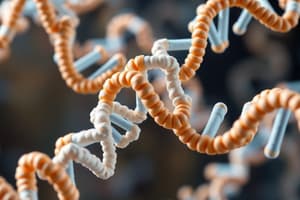Podcast
Questions and Answers
Where does translation occur within a cell?
Where does translation occur within a cell?
- In the endoplasmic reticulum
- In the cytoplasm (correct)
- In the ribosome
- In the nucleus
What is the function of the anticodon on the tRNA molecule?
What is the function of the anticodon on the tRNA molecule?
- To attach to the mRNA molecule
- To code for the start codon
- To pair with the mRNA codon (correct)
- To bind with specific amino acids
What is the role of the start codon in the translation process?
What is the role of the start codon in the translation process?
- It acts as a signal to end translation
- It is a binding site for tRNA
- It codes for a specific amino acid
- It signals the beginning of translation (correct)
What type of bond is formed between two amino acids during translation?
What type of bond is formed between two amino acids during translation?
What happens when a stop codon is reached during translation?
What happens when a stop codon is reached during translation?
Flashcards are hidden until you start studying
Study Notes
Translation
- Translation occurs in the cytoplasm.
- mRNA leaves the nucleus through a nuclear pore and attaches to a ribosome.
- tRNA molecules are single-stranded RNA molecules that fold into a clover-like structure.
- tRNA molecules have an anticodon (a triplet of unpaired bases) and a specific amino acid binding site.
- There are approximately 20 different tRNA molecules, each with a unique anticodon and amino acid binding site.
- tRNA molecules bind with their specific amino acids in the cytoplasm.
- tRNA molecules bring amino acids to the mRNA molecule on the ribosome.
- The anticodon on each tRNA molecule pairs with a complementary codon on the mRNA molecule.
- The start codon (AUG) signals the beginning of translation.
- AUG codes for the amino acid methionine.
- Two tRNA molecules bind to the ribosome at a time, bringing their amino acids side by side.
- A peptide bond is formed between the two amino acids through a condensation reaction.
- Translation continues until a stop codon is reached on the mRNA molecule, signaling the end of the process.
- The complete amino acid chain forms the final polypeptide.
Studying That Suits You
Use AI to generate personalized quizzes and flashcards to suit your learning preferences.




